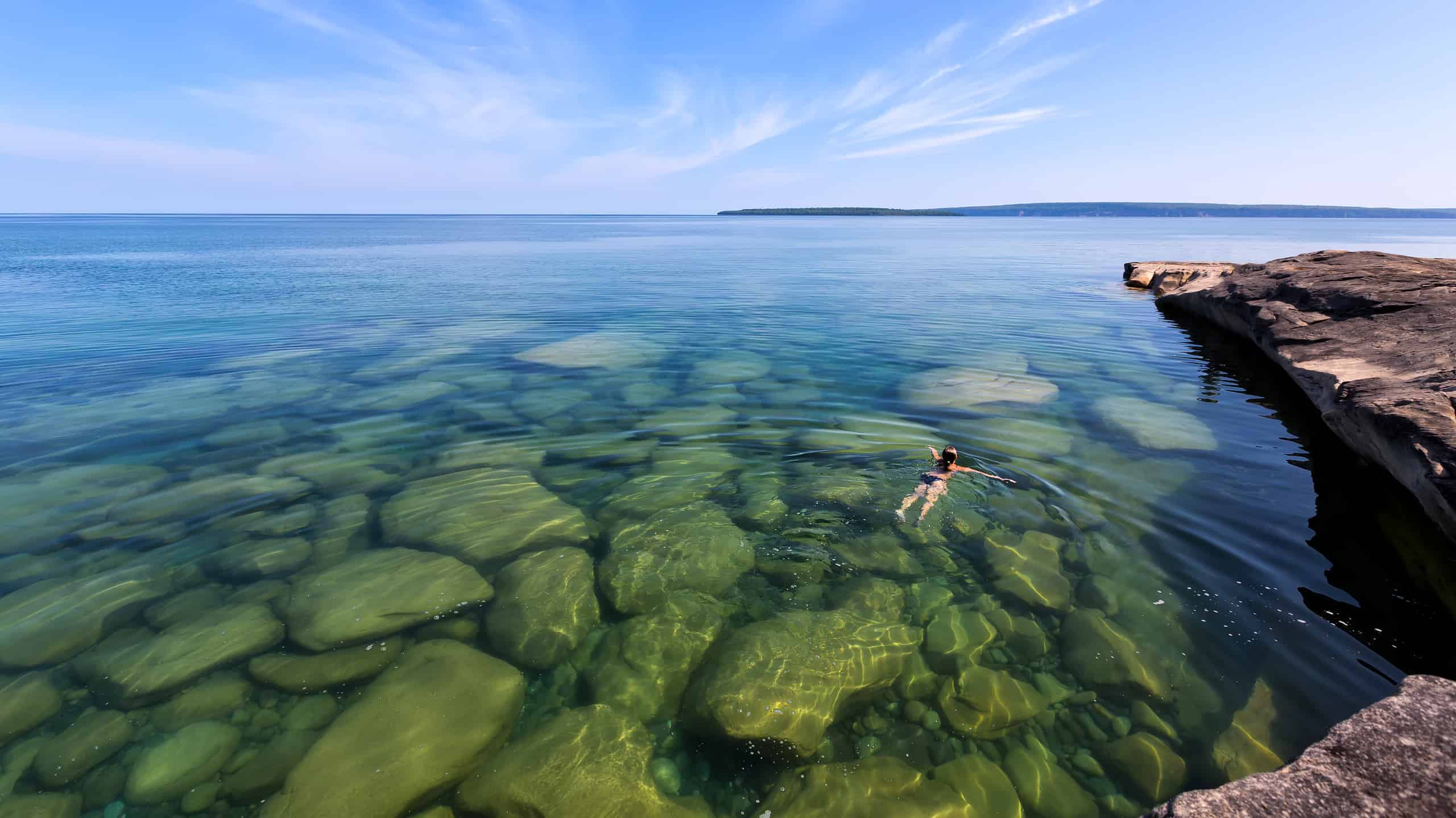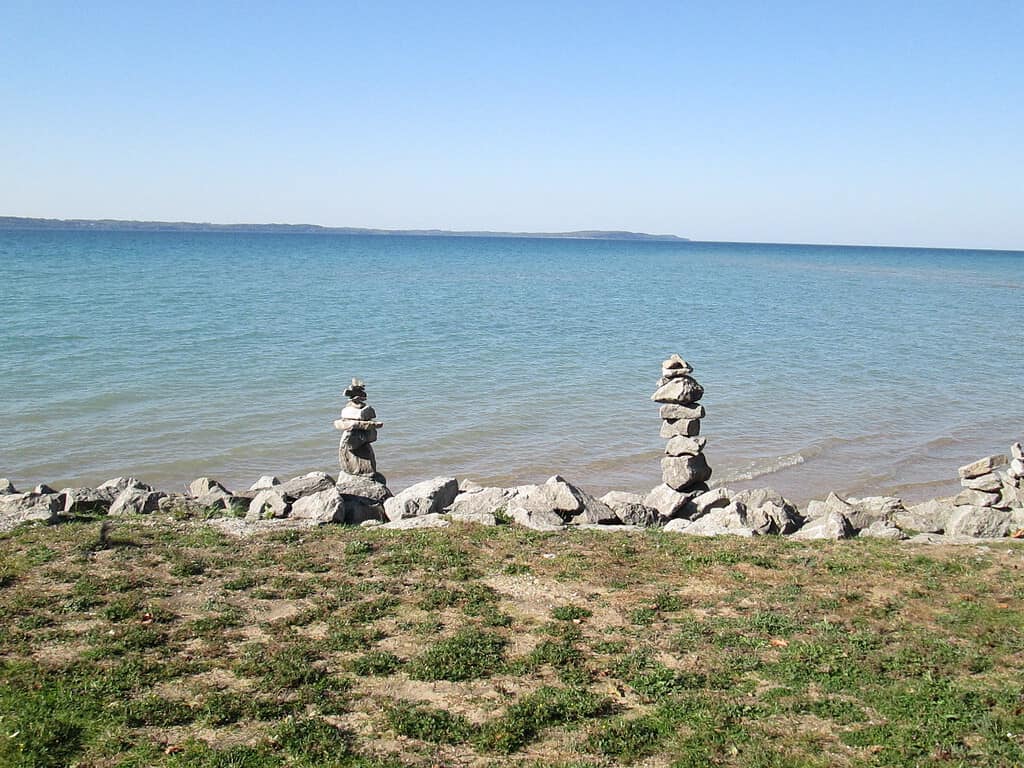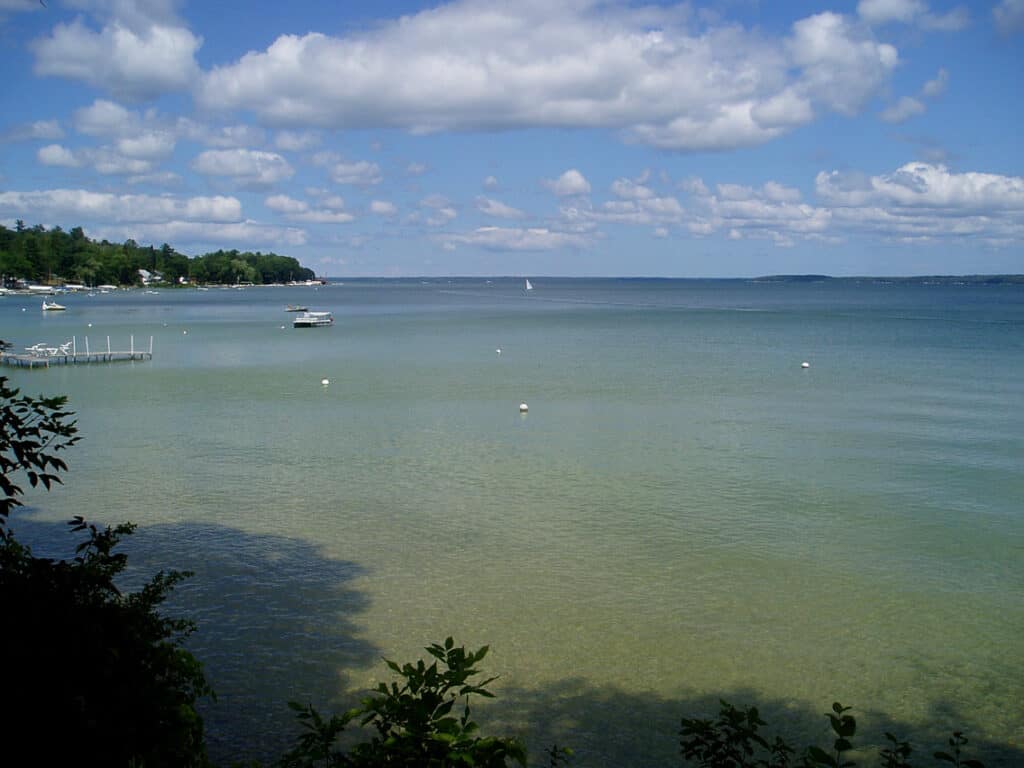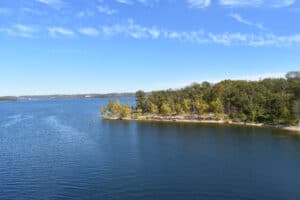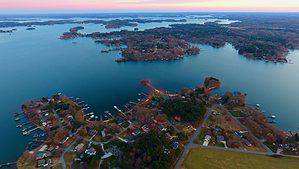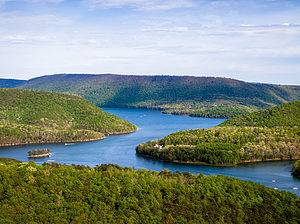Michigan is home to 62,798 inland lakes, 11,000 of which are five acres or more. In addition to these thousands of inland lakes, Michigan is also surrounded by the five Great Lakes. Surprisingly, most of the state’s lakes were created by melting glaciers dating back to the Ice Age. Eventually, the resulting deep, cold freshwater brought valuable economic resources to Michiganders through fishing, shipping, tourism, and recreational activities. Read on to discover the 25 largest lakes in Michigan.
25. Long Lake
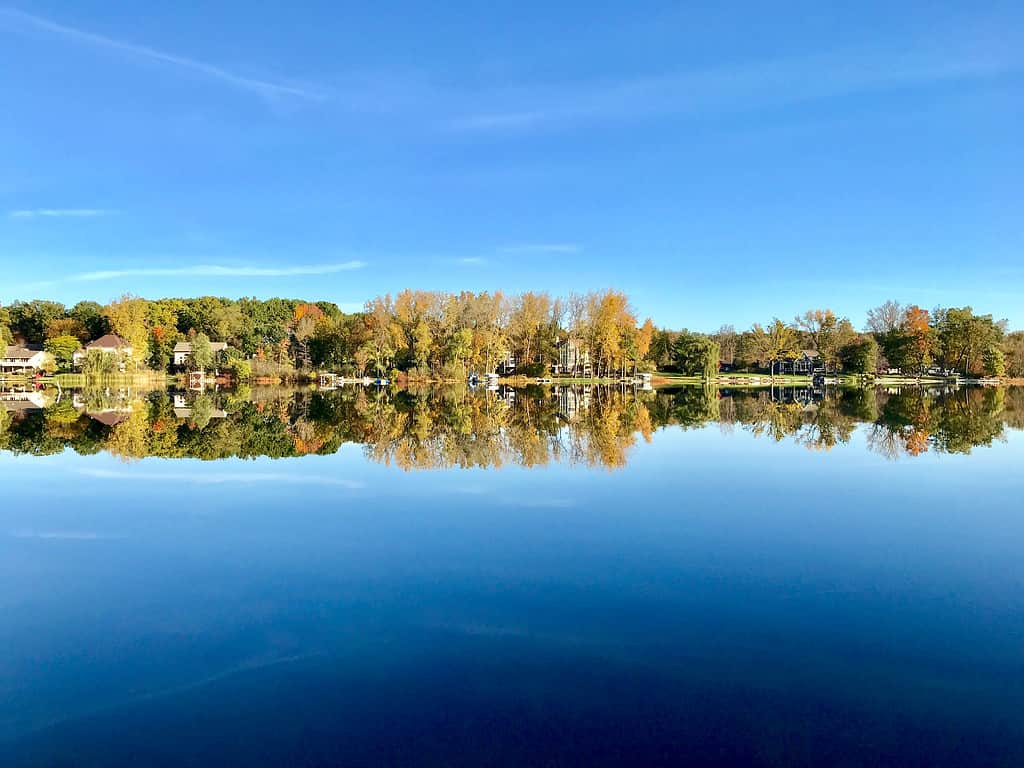
Autumn foliage is reflected in the amazingly still, clear water of Long Lake.
©Jessalyn Camp/Shutterstock.com
Long Lake is in Alpena, Michigan. With a maximum depth of 70 feet, the lake stretches along 25 feet of shoreline. This 5,652-acre lake is one of Michigan’s beautiful inland lakes. It’s also an important wildlife habitat, home to a large nesting population of loons. The lake is the primary source of the Platte River, which flows westward and eventually empties out into Lake Michigan.
24. Grand Lake
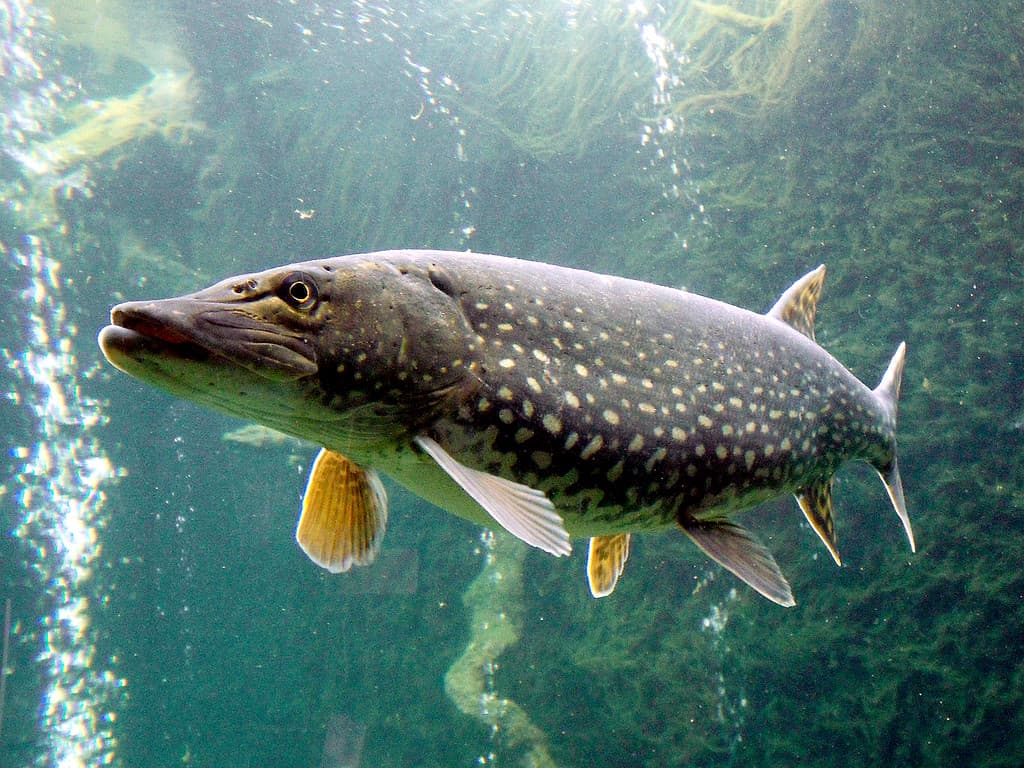
Grand Lake is filled with fantastic fish including northern pike.
©Jik jik, CC BY-SA 3.0, via Wikimedia Commons – Original / License
A spring-fed lake, Grand Lake has 5,660 acres of excellent fishing waters. The maximum depth of the lake is 20 feet, but it houses 19 individual little islands. Grand Lake is considered an all-sports lake with a variety of fish in its habitat, but it’s perfect for swimming as well.
23. Glen Lake
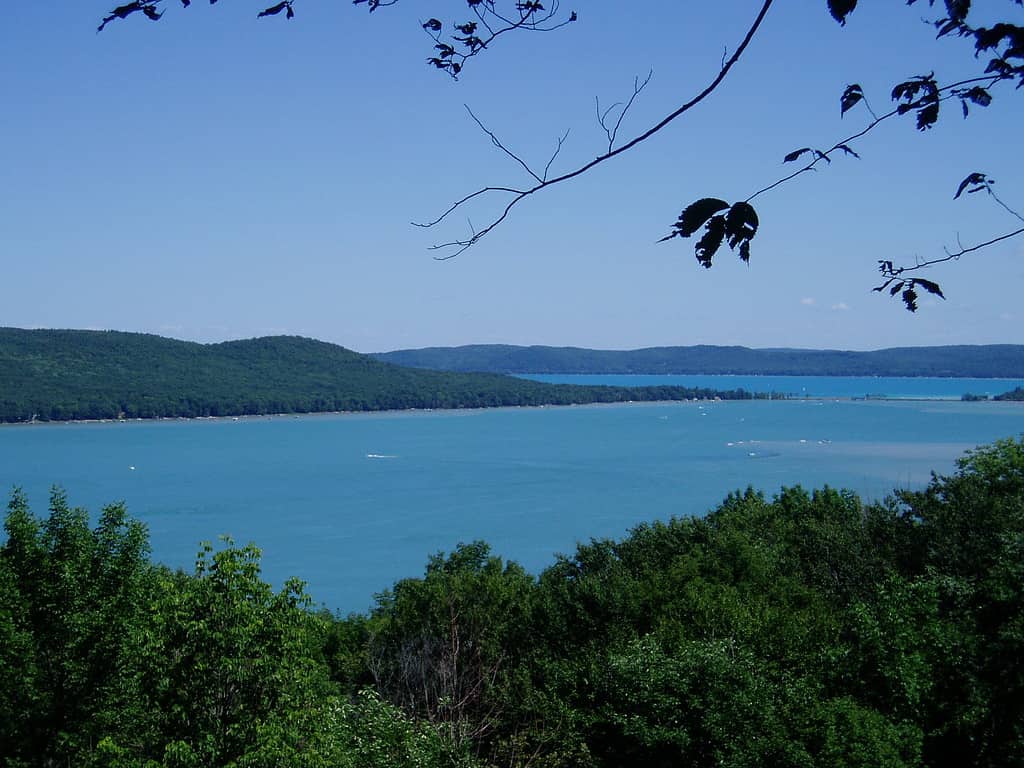
This beautiful view of Glen Lake illustrates its stunning blue water.
This lake is actually comprised of two lakes — Big Glen Lake and Little Glen Lake. However, the two individual lakes are connected by a narrow channel. As a result of the connection, the area of both lakes together is 6,286 acres. Its maximum depth reaches 130 feet, and its waters are a spectacularly clear indigo blue. Glen Lake provides 65 miles of shoreline for gorgeous beaches.
22. Michigamme Reservoir

The Peshekee Bridge at the Michigamme Reservoir serves as a familiar landmark.
As a result of a power dam built in the late 1940s, the Michigamme Reservoir became a large body of water resembling a lake. The surface area is about 7,200 acres, although it is reduced to 3,700 acres with the winter drawdown. The average depth of the reservoir is 16 feet with a maximum depth of 70 feet. Despite being a manmade lake, the reservoir is an excellent fishing spot.
21. Elk Lake
As Michigan’s second deepest inland lake, Elk Lake has a maximum depth of 195 feet. Its 8,194 acres of water stretches along 28 miles of shoreline. It is one of 14 lakes in the Antrim Chain of Lakes, and its waters are so clear and aquamarine in color that the lake seems unreal.
20. Indian Lake
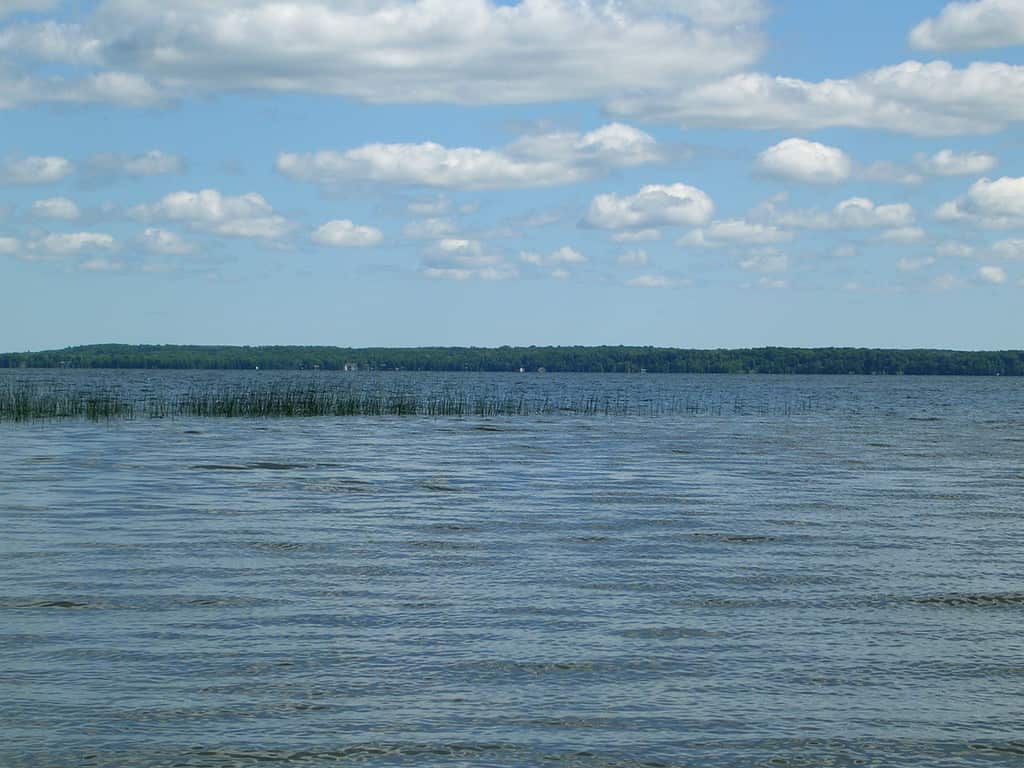
In the southwestern portion of Michigan’s Lower Peninsula, Indian Lake is one of Michigan’s largest lakes.
Indian Lake is another spring-fed Michigan lake located in the southwestern part of the state. Its maximum depth is 28 feet, and it has approximately 8,400 acres of fish-filled waters. Of the 25 largest lakes in Michigan, Indian Lake has the shortest shoreline at 16.7 miles.
19. Lake Leelanau
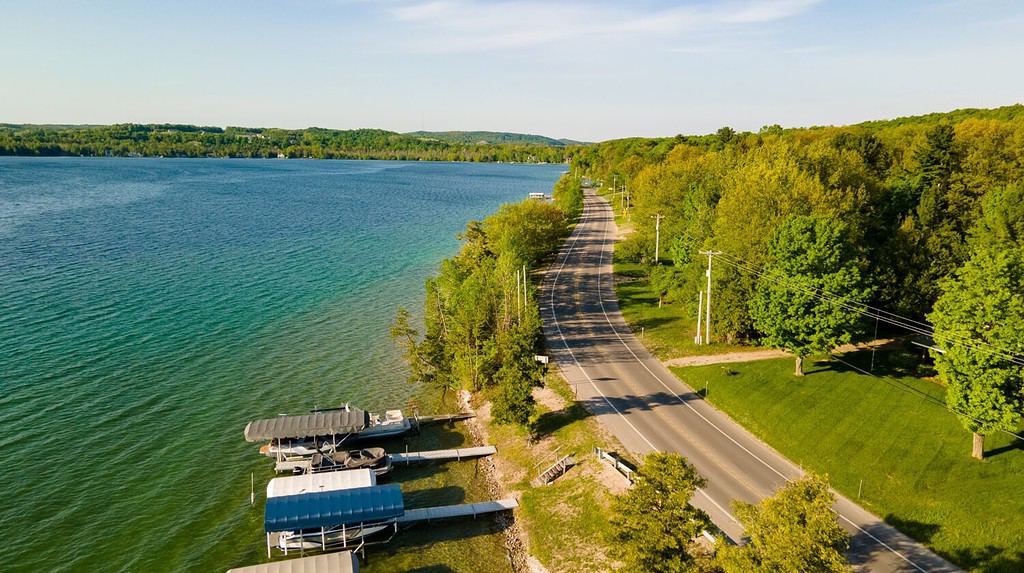
This lake is located on the Leelanau Peninsula in the northwestern part of Michigan’s lower peninsula.
©Matthew G Eddy/Shutterstock.com
Sometimes referred to as Carp Lake, Lake Leelanau is comprised of two bodies of water — North Lake Leelanau and South Lake Leelanau. Because of the composition of both stunning lakes, they hold about 8,608 acres of water. Significantly, the lake connects to Lake Michigan through the Leelanau River. Additionally, Lake Leelanau boasts 35 miles of gorgeous shoreline.
18. Hubbard Lake
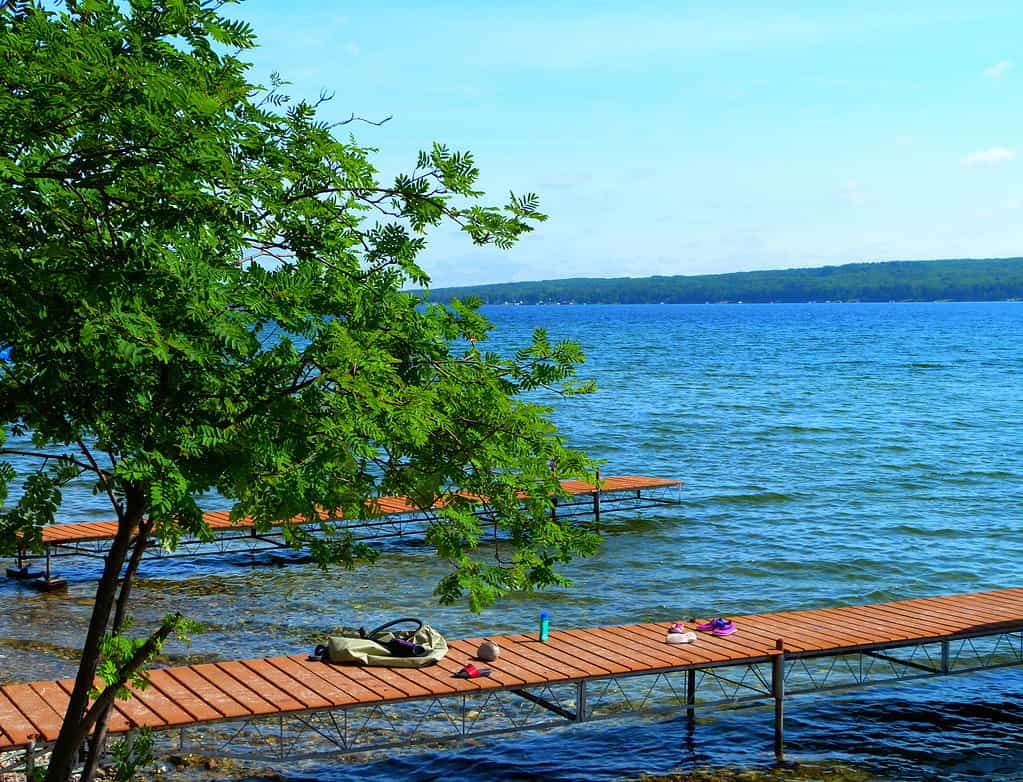
Located in Michigan’s Lower Peninsula, Hubbard Lake is the 18th largest lake in Michigan.
Hubbard Lake is an 8,850-acre lake with a maximum depth of 85 feet. Its average depth is 32.6 feet. The lake was previously called Coral Lake and Alcona Lake until 1867 when it was finally named after Dr. Bela Hubbard. At the time, Hubbard was a prominent Michigan geologist.
17. Fletcher Pond
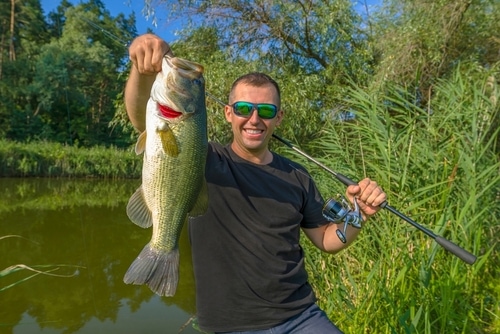
Sometimes called Fletcher Floodwaters or Fletcher Flooding, Fletcher Pond is in Alpena County, MI.
©FedBul/Shutterstock.com
Fletcher Pond was formed in 1930 when the Alpena Power Company created it to store water. It’s a shallow body of water with an average depth of just 5 feet and a maximum depth of less than 10 feet. This 8,970-acre body of water supports bass and pike and provides nesting areas for osprey. While ponds are typically less than 200 acres, this pond is more the size of a lake.
16. Higgins Lake
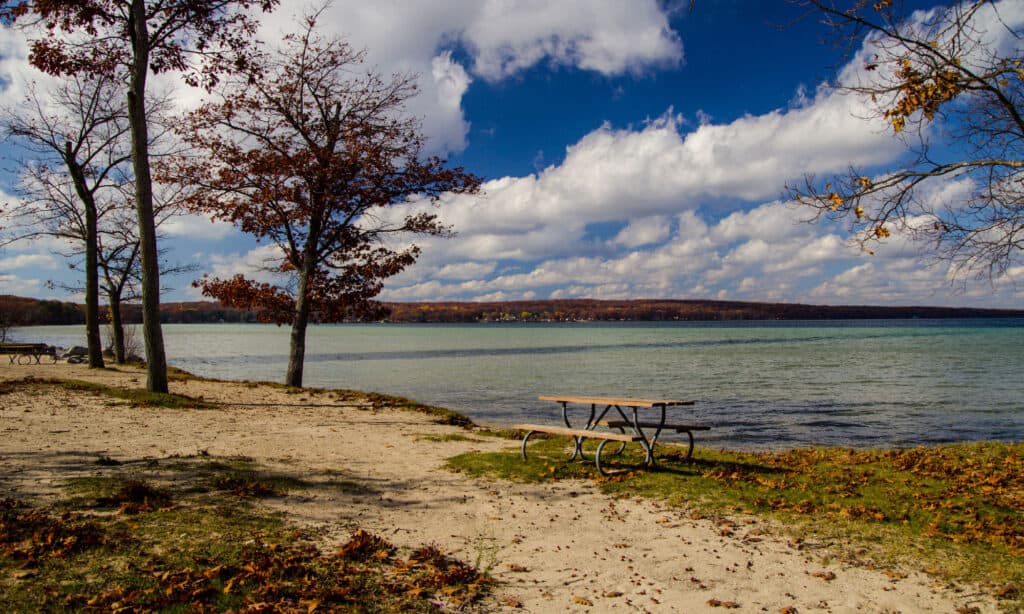
Higgins Lake holds the distinction of being one of the world’s most beautiful lakes.
©iStock.com/ehrlif
Crystal-clear water and a beautiful shore have earned Higgins Lake the designation by National Geographic as the sixth most beautiful lake in the world. The epithet is due to the 9,600 acres of gorgeous water and its 21 miles of beautiful shoreline. The maximum depth of the lake is 135 feet, and it holds about 20 billion cubic feet of water.
15. Portage Lake
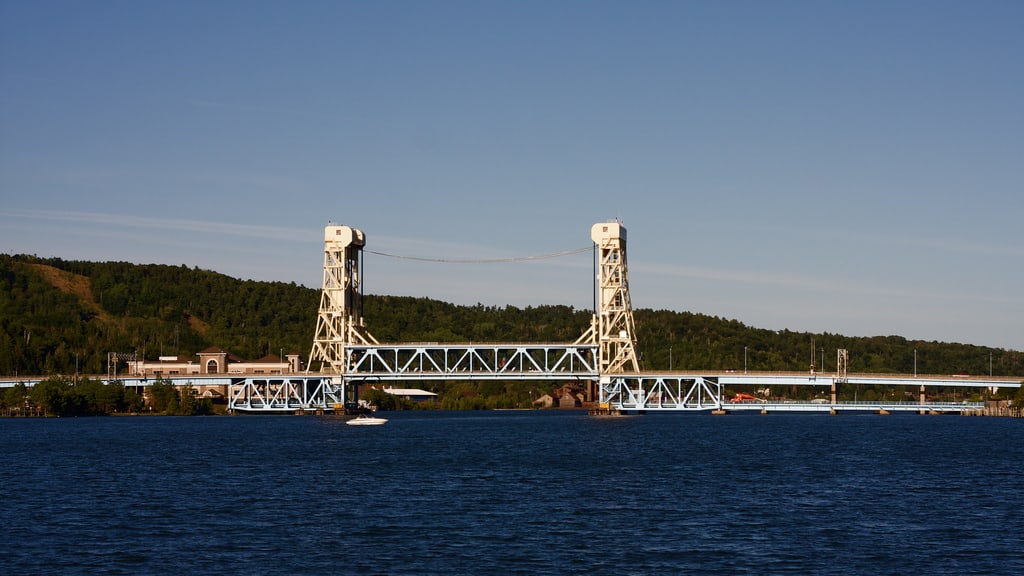
Formed from glaciers 10,000 to 75,000 years ago, Portage Lake is the 15th largest lake in Michigan.
Portage Lake is located in Houghton County in the Upper Peninsula of Michigan. Since the lake divides two areas of land, the Portage Lift Bridge was built in 1959 to connect the towns of Houghton and Hancock. The average depth of the lake is 24 feet, while it is 54 feet at its maximum depth. The lake covers 9,640 acres in one of the northernmost areas of the state.
14. Crystal Lake
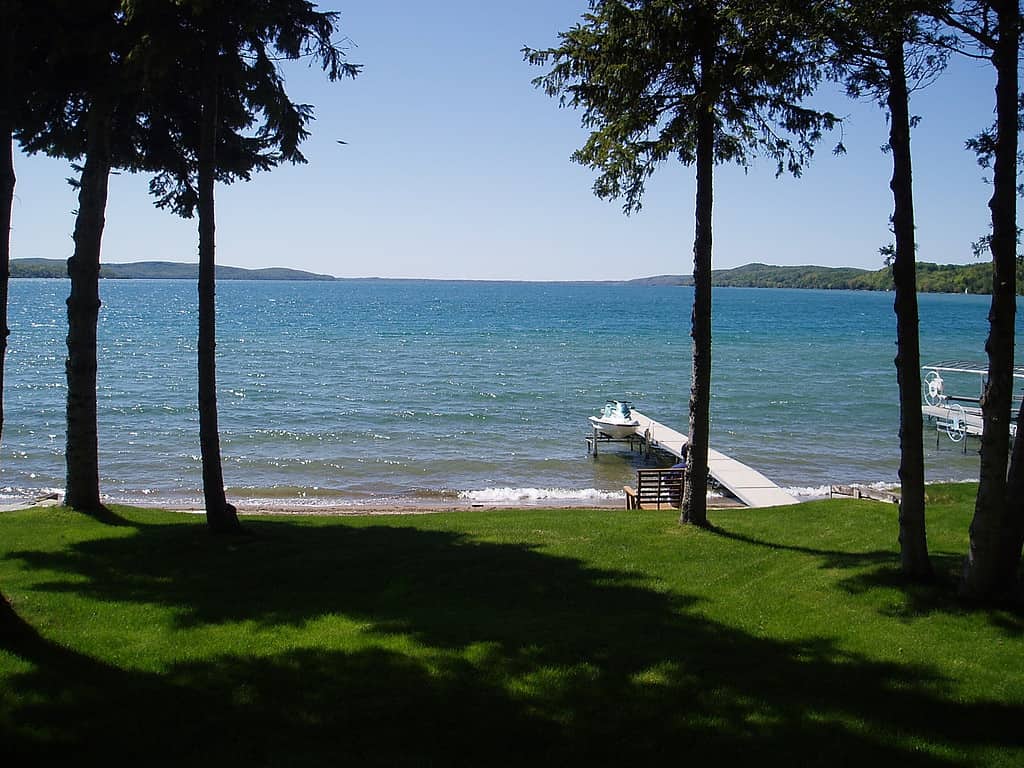
Stunning Crystal Lake in Michigan has turquoise-hued waters reminiscent of a tropical paradise.
With 9,854 acres of some of the most gorgeous water in Michigan, Crystal Lake is a popular destination for all things water recreation. Due to its dazzling water and gorgeous shore, the lake attracts hundreds of visitors each summer. The lake is 165 feet at its deepest spot, while its average depth is about 71 feet.
Although the lake’s depth is notable, it actually lost 20 feet of depth in 1873 when the Benzie Co. River Improvement Co. tried to create a canal between it and the Platte Lake and Betsie Lake. When the temporary dam was washed out, Crystal Lake’s water level was lowered by 20 feet, and it lost 25% of its area and volume.
13. Black Lake
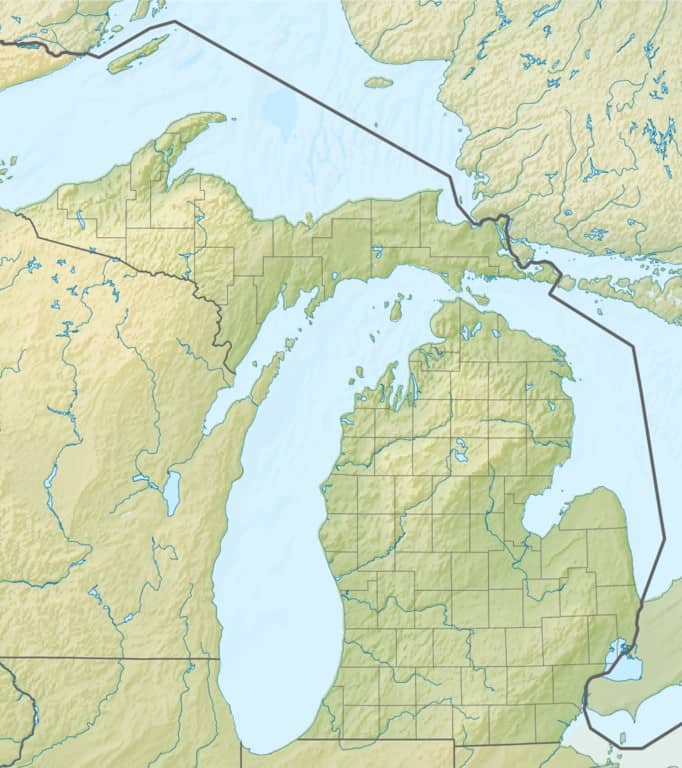
Black Lake is located in the Tip of the Mitt Watershed Council area.
One of the largest lakes in its watershed, Black Lake’s primary inflows are the Black River, Mud Creek, Rainy River, and Stewart Creek, while it flows out into the Lower Black River. With its approximately 10,000 acres of water that host a walleye fishery, Black Lake is a popular recreational lake. Its maximum depth is 50 feet, and it is nestled within 19 miles of shoreline.
12. Big Manistique Lake
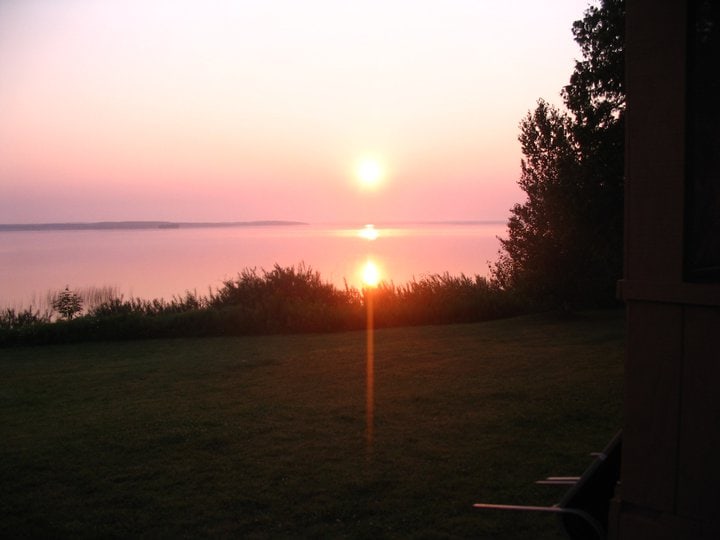
The sunset over one of Michigan’s largest lakes is dazzling.
Manistique Lake, the twelfth largest in Michigan, is located in the southern part of the state’s Upper Peninsula. Though it’s called Manistique Lake, it is really a complex of lakes comprised of several lakes, Big Manistique Lake being the largest. With 10,130 acres of water, its average depth is merely 10 feet, and its deepest point is only 20 feet. Furthermore, the lake is a popular recreational fishing spot.
11. Lake Gogebic
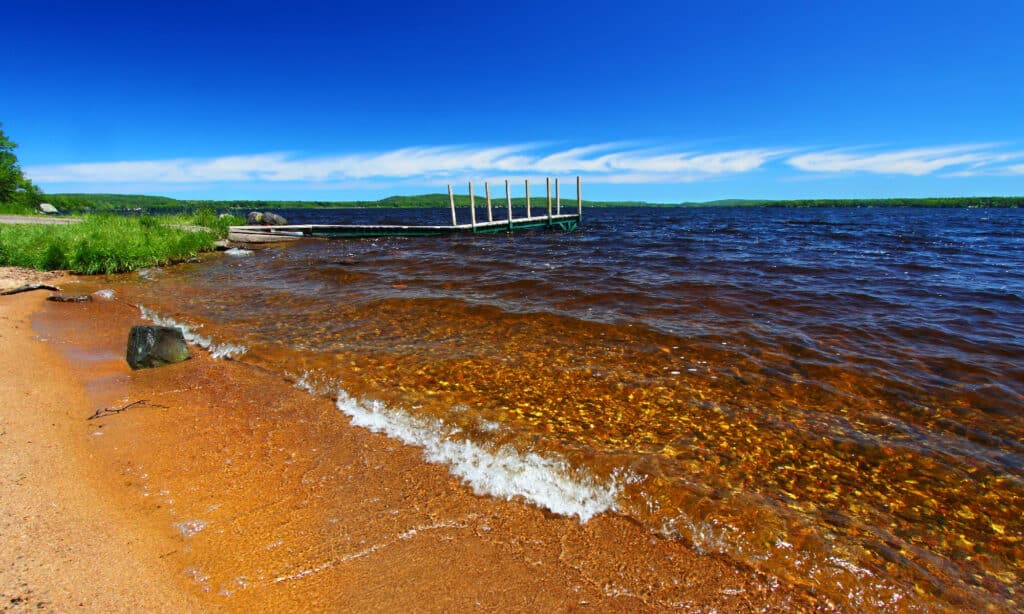
Lake Gogebic is the largest lake in the Upper Peninsula of Michigan.
©Jason Patrick Ross/Shutterstock.com
Another Upper Peninsula lake, Lake Gogebic is located in upper Michigan’s westernmost tip. Its 13,380 acres of water are home to a variety of fish. With an average depth of 17.5 feet, its deepest point reaches 38 feet. Additionally, the lake is surrounded by almost one million acres of the Ottawa National Forest.
10. Mullett Lake
Named after John Mullett who made a federal survey of the surrounding area in the early 1840s, Mullett Lake is located in the northern tip of Michigan’s Lower Peninsula. It’s the 10th-largest lake in Michigan with 16,630 acres of azure water. Also, the deepest point of this spectacular lake is 120 feet.
9. Burt Lake
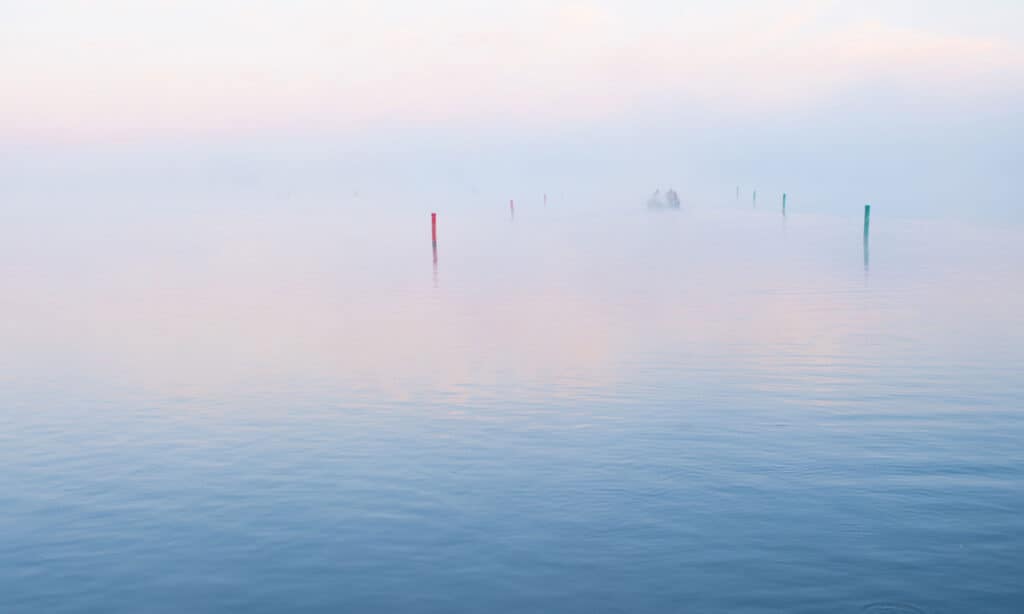
Burt Lake is located in northcentral Michigan and west of Mullet Lake.
©Ross Ellet/Shutterstock.com
With 17,120 acres of water, Burt Lake is part of the Cheboygan River Watershed. It is 73 feet at its maximum depth, and it stretches across 35 miles of shoreline. In contrast to its neighboring lake, Lake Mullet, Burt Lake is a drainage lake. As a result, water is retained for a year in the lake, and then it’s flushed out.
8. Lake Charlevoix
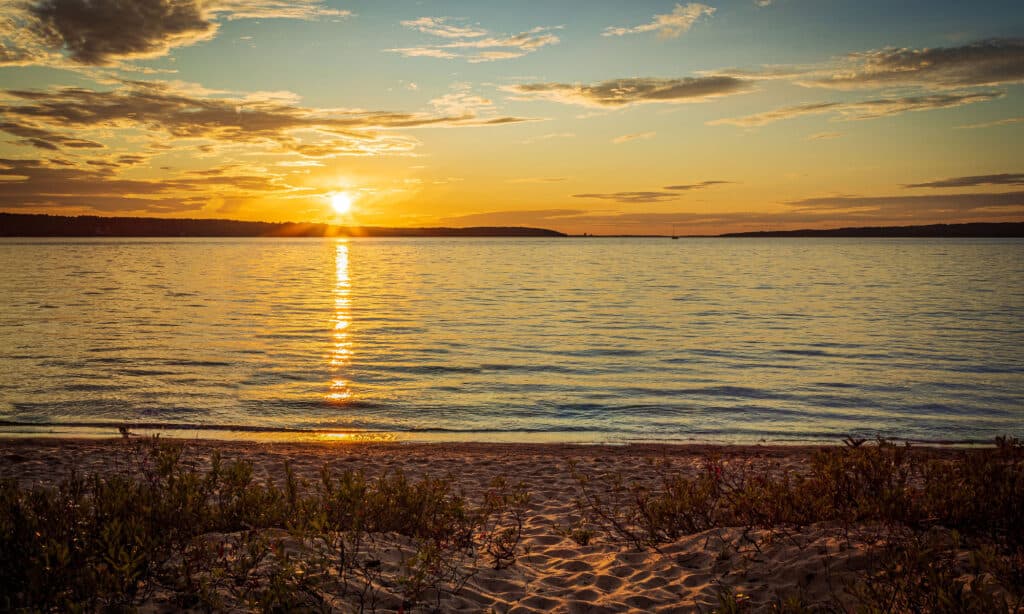
Lake Charlevoix is the subject of many Ernest Hemingway works.
©iStock.com/Paul Massie Photography
Directly connected to Lake Michigan by the Pine River Channel, Lake Charlevoix has a fluctuating water level. A USA Today poll voted this gorgeous lake the second-best American Lake in a 2012 poll, following only Lake Tahoe. Covering 17,200 acres, its maximum depth is 122 feet. As a result, it is the third-largest inland lake and eighth-largest lake in the state.
7. Torch Lake
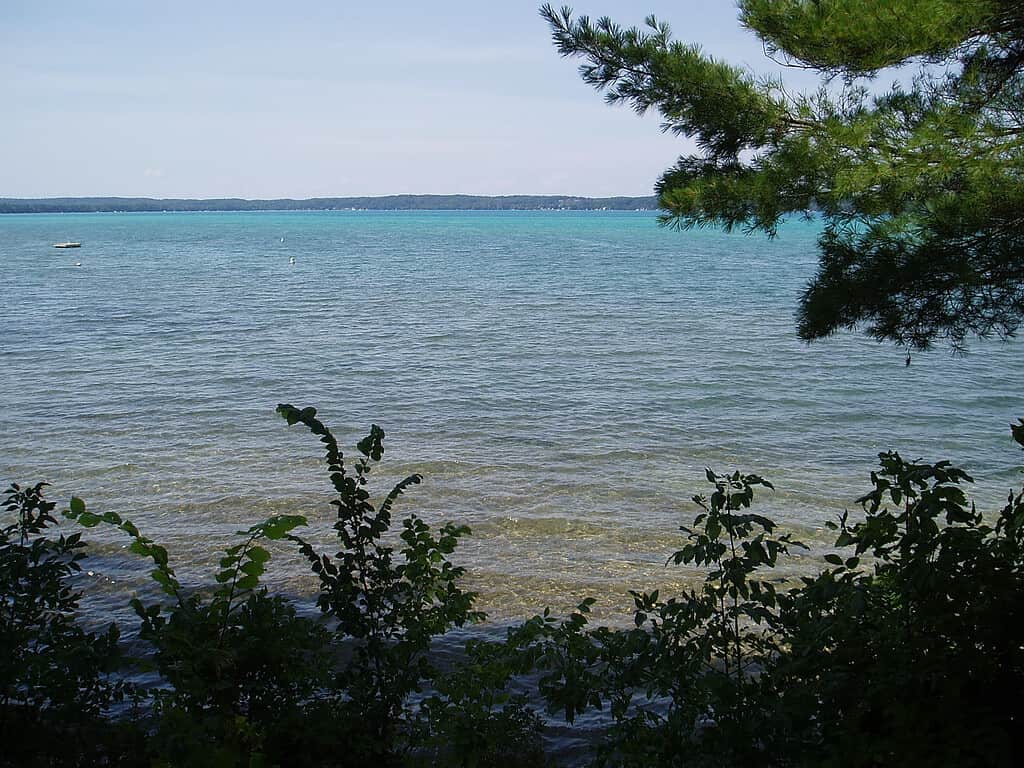
Dubbed the “Caribbean of the North,” Torch Lake boasts spectacular blue water that is incomparable.
Another amazing Michigan lake, National Geographic named this seventh-largest lake the third-most beautiful lake in the world. It holds 18,770 acres of blue-green water that make it the “Caribbean of the North.” As a result, it has become a popular vacation destination. The average depth of Torch Lake is 111 feet, and its deepest point is 285 feet.
6. Houghton Lake
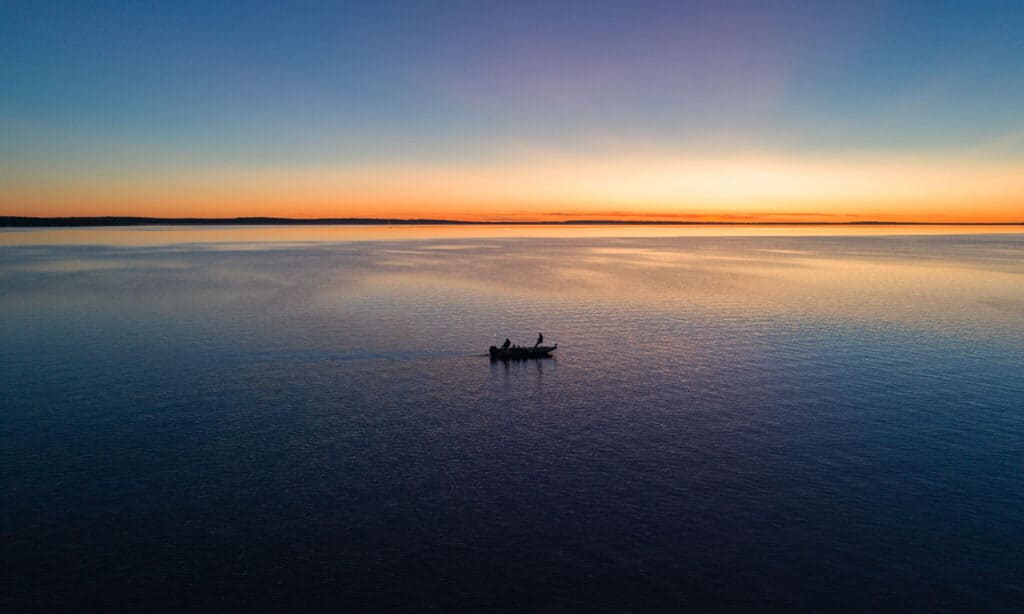
Because of its inherent beauty, people love visiting this sixth-largest Michigan lake in all seasons.
©HoverSolutions/Shutterstock.com
Houghton Lake is located in the northern portion of Michigan’s Lower Peninsula. This inland lake has 20,444 acres of prime fishing waters. At its deepest point, it’s 22 feet. Surprisingly, the average depth of the lake is only 7.5 feet.
5. Lake St. Clair
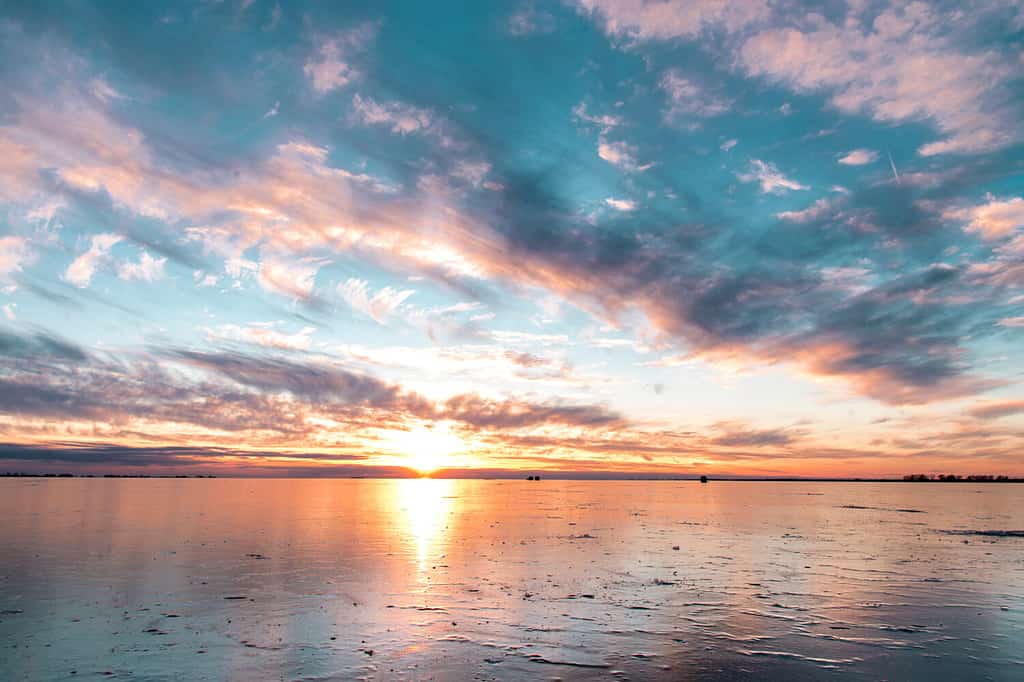
Despite Lake St. Clair’s significant size, it is often excluded from the official list of “Great Lakes.”
©Jdkfoto/Shutterstock.com
Lake St. Clair has been called the “Sixth Great Lake” due to its size and how it connects Lakes Huron and Erie through the St. Clair and Detroit Rivers. Although it’s expansive, its greatest depth is merely 19 feet, and its average depth is only 11 feet. This integral part of the Great Lakes system boasts 275,000 acres of surface area.
4. Lake Erie

Lake Erie’s drainage basin is the most densely populated of the five Great Lakes basins.
It may be the smallest of North America’s Great Lakes, but Lake Erie stretches along 871 miles of magnificent shoreline. With an average depth of 62 feet and a maximum depth of 210 feet, its smaller size often results in its freezing completely over in the winter. Lake Erie covers 6.362 million acres with a drainage basin covering parts of Michigan, Indiana, Ontario, Ohio, New York, and Pennsylvania.
3. Lake Michigan
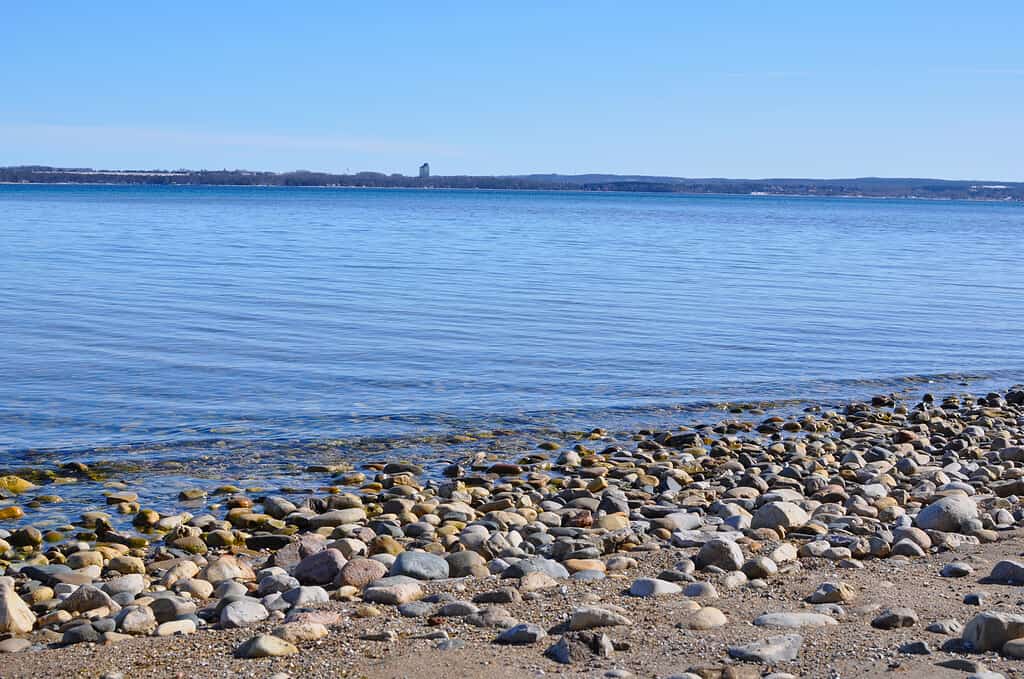
Lake Michigan is the third largest of Michigan’s lakes.
©KURJANPHOTO/iStock via Getty Images
Another one of the Great Lakes, Lake Michigan is the second-largest lake by volume and the third largest by area. With 14.339 million acres of surface area, it follows Lake Huron in size. However, its 1,180 cubic miles of volume beats Lake Huron’s 850 cubic miles. The average depth of Lake Michigan is 279 feet, but its deepest point is 923 feet. Surprisingly, Lake Michigan is the only one of the five Great Lakes that is completely within the United States’ borders.
2. Lake Huron
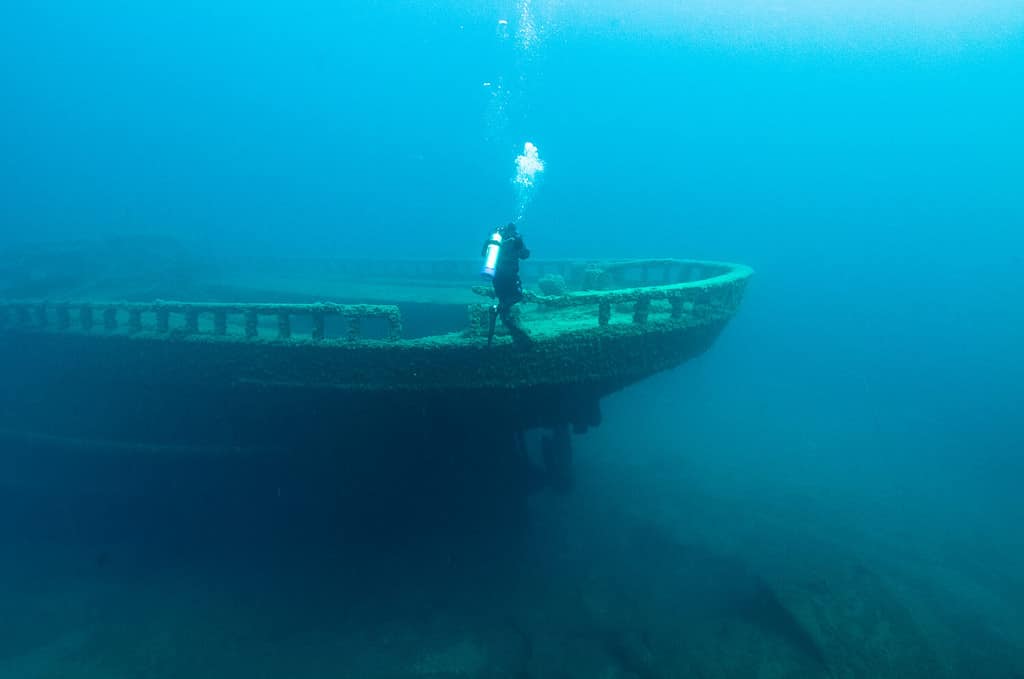
Given that Lake Huron has had an abundance of shipwrecks, divers enjoy the lake’s depths.
©lego 19861111/Shutterstock.com
Lake Huron is also one of the five Great Lakes of North America. It stretches across 14.724 million acres and connects to Lake Michigan by the Straits of Mackinac. At its maximum depth, Lake Huron plunges to an incredible 750 feet. But it’s the area that makes it the third-largest freshwater lake on Earth.
1. Lake Superior
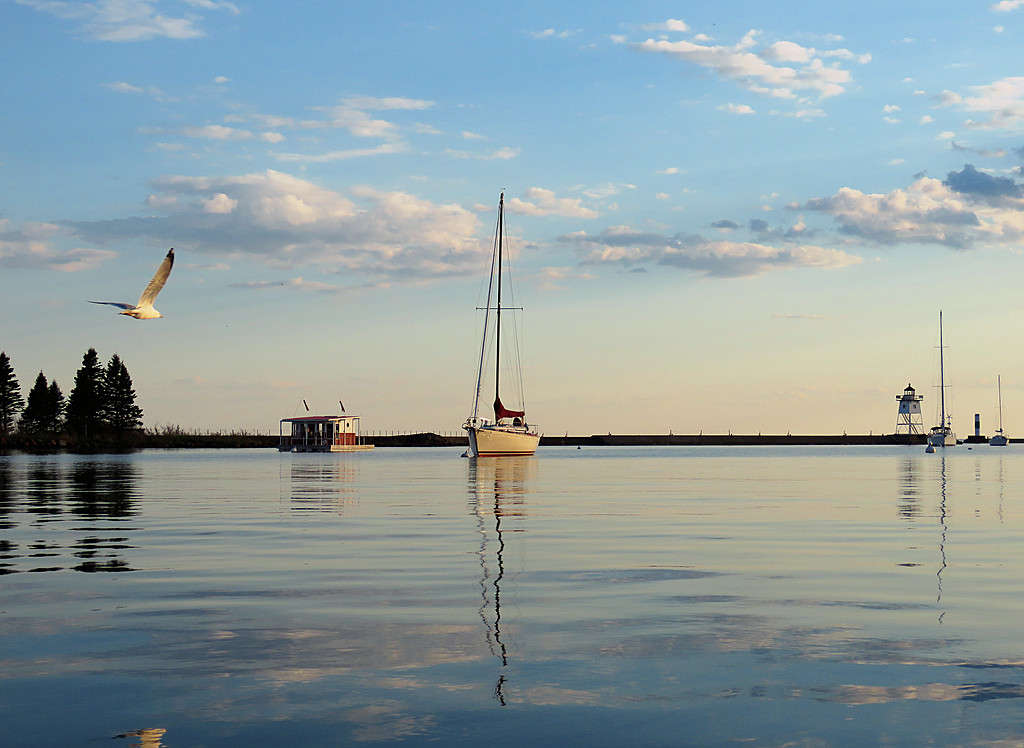
Lake Superior is the largest lake in Michigan and is, therefore, an essential waterway for boats.
The largest lake in Michigan is Lake Superior, covering 24,128,000 acres. It’s, undeniably, the largest freshwater lake in the entire world. Because its surface area is 31,700 square miles, it provides the world with 10% of its freshwater. Consequently, Lake Superior is the deepest and coldest of the Great Lakes, with the vastest point being 1,332 feet deep.
The area was initially inhabited by the Anishinaabe, who called the lake Gitchi-Gami meaning “great sea.” When looking from anywhere along the 2,726 miles of shoreline across the lake, all you can see is water. Unquestionably, Lake Superior really is like a sea.
Summary of the 25 Largest Lakes in Michigan
| Rank | Michigan Lake | Surface Area |
|---|---|---|
| 1 | Lake Superior | 5,652 acres |
| 2 | Lake Huron | 5,660 acres |
| 3 | Lake Michigan | 6,265 acres |
| 4 | Lake Erie | 7,200 acres |
| 5 | Lake St. Clair | 7,730 acres |
| 6 | Houghton Lake | 8,000 acres |
| 7 | Torch Lake | 8,520 acres |
| 8 | Lake Charlevoix | 8,850 acres |
| 9 | Burt Lake | 8,910 acres |
| 10 | Mullett Lake | 9,600 acres |
| 11 | Lake Gogebic | 9,640 acres |
| 12 | Big Manistique Lake | 9,711 acres |
| 13 | Black Lake | 10,000 acres |
| 14 | Crystal Lake | 10,130 acres |
| 15 | Portage Lake | 13,380 acres |
| 16 | Higgins Lake | 16,630 acres |
| 17 | Fletcher Pond | 17,120 acres |
| 18 | Hubbard Lake | 17,200 acres |
| 19 | Lake Leelanau | 18,770 acres |
| 20 | Indian Lake | 20,444 acres |
| 21 | Elk Lake | 275,200 acres |
| 22 | Michigamme Reservoir | 6.362 million acres |
| 23 | Glen Lake | 14.339 million acres |
| 24 | Grand Lake | 14.724 million acres |
| 25 | Long Lake | 24.128 million acres |
Thank you for reading! Have some feedback for us? Contact the AZ Animals editorial team.

